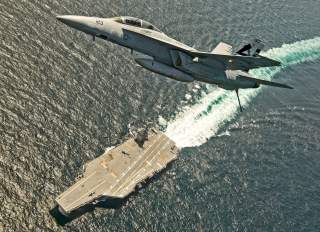How the Navy's New Gerald Ford Aircraft Carrier Will Be Able to Launch Super-Fast Air Attacks
A big improvement.
(Washington, D.C.) Navy weapons developers say the service’s emerging Ford-class carriers are engineered for the purpose of enabling a high volume of high-speed, overwhelming air attacks in rapid succession, as compared to today’s Nimitz-class carriers ….all due to new technologies and the design configuration of the platforms.
The Ford carriers, now on the cusp of entering operational service, are built with a larger deck space to enable a higher sortie rate for attack missions. In addition, there are other technologies built into the Ford class that create the opportunity to quickly rearm and refuel fighters, rapidly sending them back into the air for further attack missions, Capt. Ron Rutan, CVN 78 (USS Ford) Program Manager, said in January at the 32nd annual Surface Navy Association symposium, Arlington, Va.
“On Nimitz-class carriers, if you have a bunch of aircraft on the deck edge, you have to bring fuel lines to those aircraft and the other aircraft cannot transit. It creates a lot of logistical problems,” Rutan explained.
Ford class carriers however, as explained by Rutan, are built such that multiple planes can be rearmed, refueled and sent back to war --- much faster.
“On Ford, the weapons elevator brings the weapons right up. The fueling stations are in the deck. The refueling and the adding of munitions are all done at once, creating quick maneuvering,” Rutan said.
Rutan also added that the Ford is better equipped when it comes to conducting high speed turns in rough seas, such as Sea State 5. (Rough Seas, 9ft waves, many whitecaps and some spray)
“On Nimitz class when we go to full speed and stop, and come all back, the whole ship is shaking. On this ship (Ford), it did not happen. On this ship (Ford) when we were all back, there were some vibrations but it was nothing like what happened on the Nimitz,” he said.
The innovations for the Ford class, which have been in development for many years now, represent elements of the Navy’s broader strategy to massively increase offensive and defensive war systems for its aircraft carriers. Not only do the new systems on Ford enable a much faster attack op-tempo from fighter jets, but they also include the planned interceptor missiles and the introduction of new platforms such as the F-35C and MQ-25 Stingray - a first of its kind carrier-launched refueling drone. The F-35C, naturally, will bring a new array of attack options for the Carrier Air Wing, including a new measure of aerial Intelligence, Reconnaissance and Surveillance (ISR). Drawing upon new sensor and targeting technology, the aerial attack range will be significantly changed, and stealth technology will enable air attack to operate in higher threat environments, such as areas containing advanced air-defenses. The arrival of the F-35C is, by all estimations, expected to change the paradigm for carrier-air attack.
These enhancements built into the Ford-class are intended to work alongside and benefit from the emergence of the MQ-25 Stingray refueler, a platform which brings the promise of potentially doubling the attack radius for carrier-launched fighters. An ability to refuel while in flight massively extends a carrier's attempt to further project power while remaining at safer stand-off distances. If the combat radius of an F-18 or F-35, on one fuel tank, reaches 300 to 400 miles or so, the aircraft will have to turn around at a certain distance from its carrier. However, if an attack platform can double that range, it can naturally travel much farther, enabling much more “dwell time” when it comes to attacks and provide the option to strike targets farther inland or from greater distances.
Therefore, it goes without saying that streamlining the acquisition and integration of these systems aligns with an aggressive Navy push to make carriers more combat capable. This strategy appears to have a few possible dimensions. While carriers typically operate in Carrier Strike Groups surrounded by cruisers, destroyers and other warships able to provide protection, a fast-changing threat environment is expected to create the need for more dispersed, or disaggregated operations. In short, carriers will need greater attack and defensive technology themselves. For this reason, the service is not only looking to streamline and accelerate the arrival of the F-35C and drone tanker, but also bring new weapons such as lasers, guns, electronic warfare and new interceptor-defense systems.
“It’s not just Hollywood, although I have never been in the President’s office when a crisis happens and the President says ‘where are the carriers?’ …. But I”m sure that is the first thing that comes to mind when issues happen or a crisis comes up. When that question is asked and the carriers start moving… the opportunity for diplomacy is here, because they know - who ever they are - that we bring to the fight an overpowering effort” Rutan said.
This article by Kris Osborn originally appeared in WarriorMaven in 2020.
Kris Osborn previously served at the Pentagon as a Highly Qualified Expert with the Office of the Assistant Secretary of the Army - Acquisition, Logistics& Technology. Osborn has also worked as an anchor and on-air military specialist at national TV networks. He has appeared as a guest military expert on Fox News, MSNBC, The Military Channel and The History Channel. He also has a Masters Degree in Comparative Literature from Columbia University.
Image: Reuters

